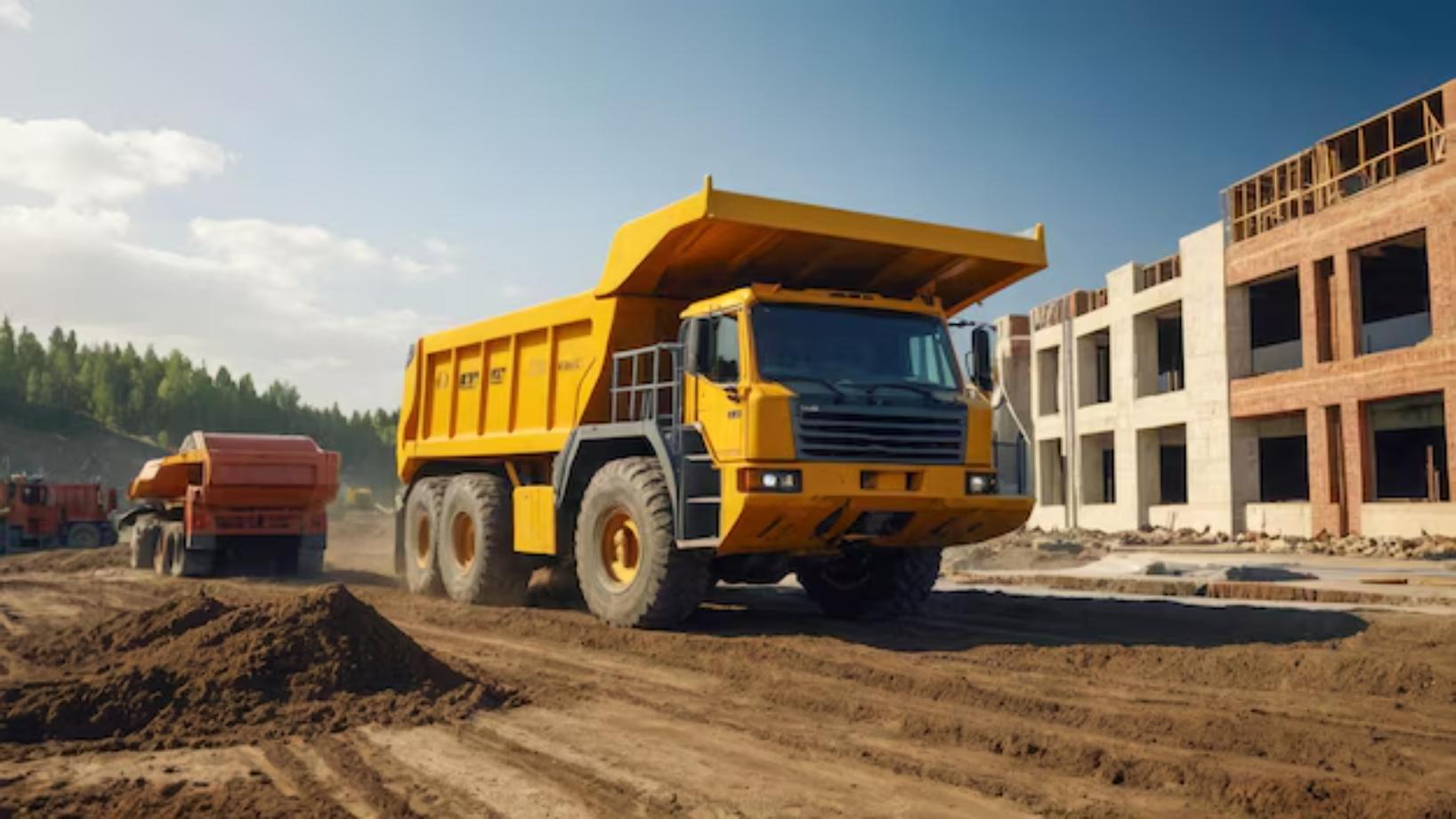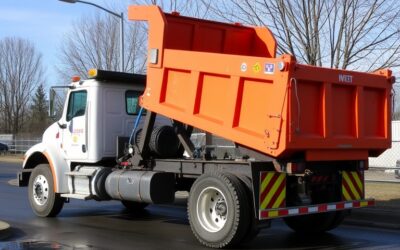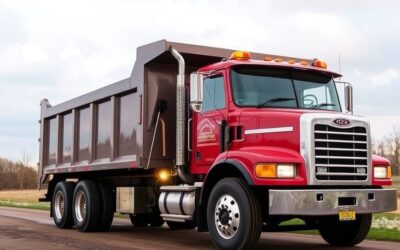Dump trucks are essential for moving massive amounts of material, but they also carry serious risks—especially tipping. When a dump truck tips, it can cause severe damage to property and injuries to people. It also leads to costly repairs and operational downtime. Knowing why these accidents happen is the key to preventing them.
Various factors can cause a dump truck to tip over. These include the distribution of the load, the condition of the terrain, and how the truck is operated. Often, a combination of these factors leads to a tipping incident. For instance, an uneven load on a steep or unstable surface can easily cause a truck to become unbalanced and tip over. Attention to detail in all these areas is crucial to maintain stability.
This article aims to explore the top reasons dump trucks tip over and provide practical solutions for preventing these accidents. From load management to safe operating practices and the role of advanced anti-tip technology, we’ll cover everything you need to know to ensure safer dump truck operations. Preventing these accidents is not only about protecting assets but also safeguarding lives.
Common Causes of Dump Truck Tipping
Dump truck tipping is a serious concern and can happen due to several reasons. Understanding these causes helps in taking preventive measures. Here are some common causes:
- Uneven Loads: Unevenly distributed loads create an imbalance in the truck bed. This imbalance can cause the truck to tip over, especially when the bed is raised to dump the load. Both overloading and partial loading can be dangerous if not managed correctly.
- Rough Terrain: Dump trucks frequently work on unstable ground like construction sites or mining fields, increasing the tipping risk. Driving on these unstable surfaces increases the risk of tipping, especially if the truck is fully loaded. The risk is higher when navigating slopes or uneven grades.
- High Wind Conditions: Strong winds can push against the large side surfaces of dump trucks. When the truck bed is raised, it acts like a sail, catching the wind and making the vehicle more likely to tip. Operators should be cautious when working in windy conditions.
- Driver Error: Inexperienced or reckless driving can significantly increase the risk of tipping. Sudden turns, harsh braking, or quick acceleration can destabilize a loaded dump truck, leading to accidents. Proper training and adherence to safety protocols are crucial to mitigate this risk.
Impact of Uneven Loads
Uneven loads are a primary factor in many dump truck tipping incidents. An uneven load shifts the truck’s center of gravity, making it unstable. Here’s how uneven loads impact dump truck operations:
- Shifting Centers of Gravity: An uneven load changes the truck’s balance. When the truck bed is raised to dump the load, the center of gravity shifts higher, increasing the risk of tipping. Ensuring that the load is evenly spread minimizes these risks.
- Material Movement: Materials like gravel or sand shift during transport, creating a sudden imbalance. If the load shifts while driving, it can create a sudden imbalance, causing the truck to tip. Securely packing the load and using proper containment methods can help prevent movement.
- Stress on Truck Components: An uneven load places more stress on certain parts of the truck, such as the tires and suspension system. Over time, this additional stress can lead to wear and tear, making the truck more susceptible to mechanical failure and tipping.
- Increased Stopping Distance: When loads are uneven, stopping distances can be affected. Sudden braking can cause the load to shift forward, destabilizing the truck. Drivers need to be aware of their load and adjust their driving style accordingly to maintain control.
Addressing the impact of uneven loads requires careful planning and proper loading techniques. Using load sensors and balance monitoring can ensure that the load remains even during the entire operation, reducing the risk of tipping.
Importance of Safe Operating Practices
Safe operating practices are critical to preventing dump truck accidents. Proper training and adherence to safety guidelines play a significant role in maintaining stability and control. Here are some key practices to follow:
- Driver Training: Comprehensive training ensures drivers know how to handle dump trucks safely in all conditions. This includes navigating slopes, uneven terrains, and understanding the truck’s load capacity.
- Regular Inspections: Routine inspections of the truck’s mechanical systems, such as the brakes, hydraulics, and suspension, ensure that the vehicle is in good working condition. Identifying and addressing issues early can prevent malfunctions that could lead to tipping.
- Controlled Speed: Controlled speeds are crucial, especially when carrying a full load. High speeds can make it difficult to control the truck and increase the likelihood of tipping, particularly when turning or stopping abruptly.
- Awareness of Environmental Conditions: Weather and ground conditions can significantly impact a dump truck’s stability. Drivers should be cautious during adverse weather conditions and avoid operating on unstable ground whenever possible.
Role of Anti-Tip Technology in Preventing Accidents
Anti-tip technology boosts dump truck safety by automatically adjusting the vehicle’s balance in real-time. This technology utilizes various sensors and systems to monitor and correct the truck’s stability, reducing the risk of tipping. Here’s how it works:
- Tilt Sensors: These sensors measure the angle of the truck bed and the vehicle itself. If the sensors detect that the truck is leaning too much to one side, they trigger an alert and enable corrective actions, such as lowering the bed back to a safe position.
- Control System: The control system processes data from the tilt sensors and other inputs like speed monitors and load sensors. This system can make real-time adjustments to the truck’s operations, like controlling the hydraulics to lower the bed or adjusting the brakes to stabilize the vehicle.
- Automatic Lowering Mechanism: This feature lowers the dump bed automatically when the system detects a risk of tipping. By redistributing the load’s weight, it helps bring the truck back to a stable state.
- Driver Alerts: Anti-tip systems often include alerts that notify the driver of potential risks. These alerts provide valuable information, allowing the driver to take additional safety measures when needed.
Conclusion
Knowing why dump trucks tip and using solutions to prevent accidents is crucial for safe operations. Uneven loads, rough terrains, and high winds are common causes that can be mitigated through better load management and safe operating practices. In addition, anti-tip technology provides an advanced layer of protection by automatically adjusting and stabilizing the truck in real-time.
By combining thorough training, regular maintenance, and cutting-edge anti-tip technology, we can significantly reduce the risk of accidents involving dump trucks. Ensuring the safety of drivers and those around them should always be a top priority.
For those looking to enhance dump truck safety further, Wink Anti-Tip offers state-of-the-art anti-tip kits designed for various types of dump trucks, including frameless, roll-off, and frame type. Explore our solutions and take a proactive step towards safer operations today. Visit Wink Anti-Tip to learn more about how our technology can make a difference.





